Catalogue > List by artist
Browse the entire list of Rencontre Internationales artists since 2004. Use the alphabetical filter to refine your search. update in progress
Yalda Afsah
Catalogue : 2021Vidourle | Documentary | mov | color | 10:0 | Germany | 2019
Yalda Afsah
Vidourle
Documentary | mov | color | 10:0 | Germany | 2019
Named after its setting, the French river Vidourle, Yalda Afsah’s film documents a strange and subtly unnerving choreography, capturing a group of young men performing what could be a ritual, a spectacle, a game, or a fight. In their collective movements as well as individual moments of concentration, anticipation and occasional forlornness, the adrenalin-fuelled adolescent protagonists seem to embody the frailty of the human condition awaiting an environmental change, much like an unexpectedly forceful current in a river.
Yalda Afsah explores how space can be cinematically constructed and the documentary character of her works often veers towards forms of theatricality. This formal characteristic of Afsah’s practice is conceptually mirrored in her documentary portraits of human-animal relationships that reveal an ambivalence between care and control, physical strength and broken will, instinct and manipulation. Afsah seeks to question and to dissolve these dichotomies, while carving out a space to reflect on the possibility of an overarching empathy between species.
Mahshid Afzali, Mirshakkak Mahoor
Catalogue : 2025A Moment of Exposure | Experimental doc. | hdv | color | 20:0 | Iran | 2024
Mahshid Afzali, Mirshakkak Mahoor
A Moment of Exposure
Experimental doc. | hdv | color | 20:0 | Iran | 2024
A moment of exposure is about observing the experience of living an idea and gathering materials for an art installation. The camera, as an attentive observer, collects memories and associations related to the "Safe & Sound" multimedia interactive exhibition. Following the process of preparation, presentation, and dismantling of the installation, we seek visual and sensory origins. In the first part of the exhibition, a spatial arrangement features elements such as metal fence sculptures, archived photos of fences in graveyards, and videos of deceased creatures floating in water. These elements are gently dissected to uncover the roots of safety and any remnants of movement left after death. In the second part, different sounds can be heard by interactive audiences resting in bed-shaped sound boxes, prompting questions about the origins of these sounds. Each sound carries the weight of a past incident, reverberating in the space and creating an immersive experience. Ultimately, the film invites viewers to reflect on the connections between memory, loss, and the lingering echoes of life. It encourages an exploration of how we find safety in remembrance and the ways in which our past shapes our present.
Mahshid Afzali: Mahshid Afzali is an Iranian Video Artist and Filmmaker, based in Tehran. She graduated from University of Tehran with a B.A. degree of Scenic Design in 2018. Throughout her studies, she developed a passion for video art as a medium for self-expression. In the past few years she specialized in independent film production and post-production and created several documentary films and videos. Mahshid is also an archivist, and documents her life through videos and photographs that often serve as the foundation for her artworks. / Mahoor Mirshakkak: Mahoor Mirshakkak, Iranian freelance Filmmaker & Sound designer. Graduated in Painting from Tehran Fine Arts University. Currently Working on Multidisciplinary installations Based on Archived sound and videos.
Sandro Aguilar
Catalogue : 2013Sinais de Serenidade por coisas sem sentido | Fiction | hdv | color | 28:0 | Portugal | 2012
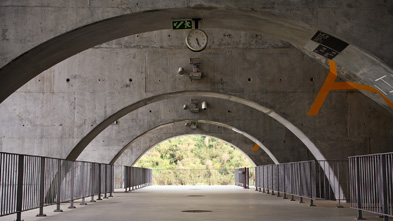
Sandro Aguilar
Sinais de Serenidade por coisas sem sentido
Fiction | hdv | color | 28:0 | Portugal | 2012
"Signs Of Stillness Out Of Meaningless Things" Sandro Aguilar Une comptine : « Quand les braises où les étincelles du feu atteignent la marmite d?eau, cela signifie qu?il vente... » Et toujours ce climat mystérieux qui hante toute l?oeuvre de Sandro Aguilar.
Sandro Aguilar
Catalogue : 2022The Detection Of Faint Companions | Experimental video | 0 | color | 14:0 | Portugal | 2021
Sandro Aguilar
The Detection Of Faint Companions
Experimental video | 0 | color | 14:0 | Portugal | 2021
Full Moon. Inside. Perhaps not alone.
Born in 1974 in Portugal, Sandro Aguilar studied film at the Escola Superior de Teatro e Cinema. In 1998, he founded the production company O Som e a Fúria. His films have won awards at festivals such as La Biennale di Venezia, Locarno FF, Gijón, Oberhausen,Vila do Conde, Indielisboa FF and have been shown in the most relevant film festivals worldwide. Two times nominated for the EFA – Best European Short Film Award. Retrospectives of his work have been programmed at Rotterdam IFF, BAFICI, New York Film Festival, Arsenal-Berlin and Oberhausen FF. In 2013, he was invited into the renowned DAAD Artist Residency, Berlin.
Sandro Aguilar
Sandro Aguilar
Catalogue : 2016Bunker | Fiction | hdv | black and white | 30:17 | Portugal | 2015
Sandro Aguilar
Bunker
Fiction | hdv | black and white | 30:17 | Portugal | 2015
A young girl spending time with her parents (a swinger couple) in a camping site meets an emotionally unstable recruit and becomes fascinated by his special powers. He falls in love with her, but he soon finds out his love is unrequited.
Born in 1974 in Portugal, Sandro Aguilar studied film at the Escola Superior de Teatro e Cinema. In 1998 he founded the production company O Som e a Fúria. His films have won awards at festivals, such as La Biennale di Venezia, Gijón, Oberhausen and Vila do Conde, and have been shown in Torino, Belfort, Montreal, Clermont-Ferrand among others. Retrospectives of his work have been programmed at Rotterdam IFF and BAFICI.
Sandro Aguilar
Catalogue : 2019Mariphasa | Fiction | 4k | color | 87:0 | Portugal | 2018
Sandro Aguilar
Mariphasa
Fiction | 4k | color | 87:0 | Portugal | 2018
Paulo works as a night guard in a building site. He lost his daughter in dramatic circumstances and no regret would ever give him a sense of closure . He often sleeps in his lover`s house where he witnesses the repeated transgressions of an unstable neighbor. Everything threatens to crack.
Born in 1974 in Portugal, Sandro Aguilar studied film at the Escola Superior de Teatro e Cinema, in Lisbon. In 1998 he founded the production company O Som e a FuÌria. His first fiction feature film was UPRISE (2008). MERCURY (2010) was in competition for the Tiger Awards for Short Films at IFFR 2011. His films have won awards at festivals, such as La Biennale di Venezia, GijoÌn, Oberhausen and Vila do Conde, and have been screened in Torino, Belfort, Montreal, Clermont-Ferrand among others. Besides being a director, Aquilar is an editor and a producer. MARIPHASA is his second feature film.
Catalogue : 2017Undisclosed Recipients | Video | hdv | color | 25:0 | Portugal | 2015
Sandro Aguilar
Undisclosed Recipients
Video | hdv | color | 25:0 | Portugal | 2015
Before and after that second kiss.
Born in 1974 in Portugal, Sandro Aguilar studied film at the Escola Superior de Teatro e Cinema. In 1998 he founded the production company O Som e a Fúria. His films have won awards at festivals, such as La Biennale di Venezia, Gijón, Oberhausen and Vila do Conde, and have been shown in Torino, Belfort, Montreal, Clermont-Ferrand among others. Retrospectives of his work have been programmed at Rotterdam IFF and BAFICI.
Sandro Aguilar
Catalogue : 2023O Teu Peso Em Ouro | Fiction | hdv | color | 26:0 | Portugal | 2022
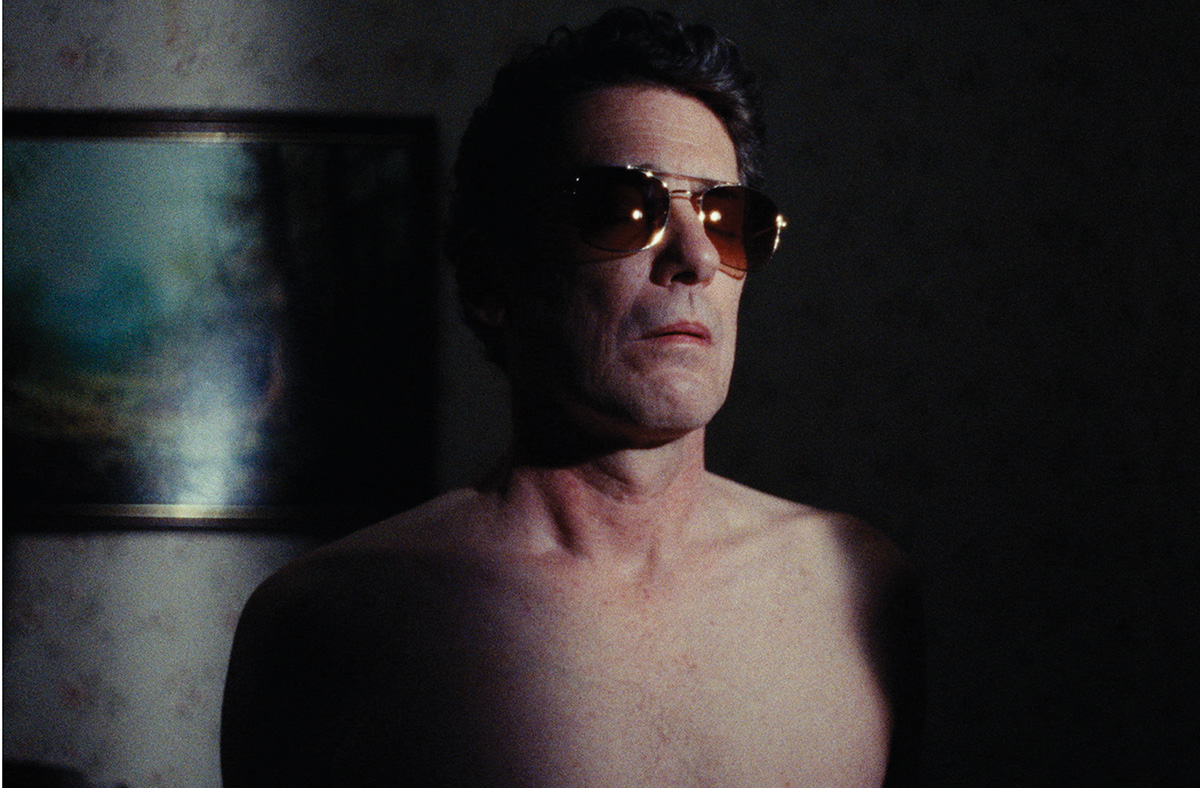
Sandro Aguilar
O Teu Peso Em Ouro
Fiction | hdv | color | 26:0 | Portugal | 2022
Oscar, a renowned hypnotherapist, takes advantage of the last moments in his hotel room to say goodbye to the dazzling Mercedes and relieve old Norberto of his sorrows
Born in 1974 in Portugal, Sandro Aguilar studied film at the Escola Superior de Teatro e Cinema. In 1998, he founded the production company O Som e a Fúria. His films have won awards at festivals such as La Biennale di Venezia, Locarno FF, Gijón, Oberhausen,Vila do Conde, Indielisboa FF and have been shown in the most relevant film festivals worldwide. Two times nominated for the EFA – Best European Short Film Award. Retrospectives of his work have been programmed at Rotterdam IFF, BAFICI, New York Film Festival, Arsenal-Berlin and Oberhausen FF. In 2013, he was invited into the renowned DAAD Artist Residency, Berlin
Catalogue : 2015FALSE TWINS | Fiction | hdv | color | 21:0 | Portugal | 2014
Sandro Aguilar
FALSE TWINS
Fiction | hdv | color | 21:0 | Portugal | 2014
Hidden memories and lost treasures of our primeval inhabitants.
Born in 1974 in Portugal, Sandro Aguilar studied film at the Escola Superior de Teatro e Cinema. In 1998 he founded the production company O Som e a Fúria. His films have won awards at festivals, such as La Biennale di Venezia, Gijón, Oberhausen and Vila do Conde, and have been shown in Torino, Belfort, Montreal, Clermont-Ferrand among others. Retrospectives of his work have been programmed at Rotterdam IFF and BAFICI.
Catalogue : 2014Dive : approach and exit | | | | 12:13 | Portugal | 0
Sandro Aguilar
Dive : approach and exit
| | | 12:13 | Portugal | 0
Before the assault, feel the weight of the body.
Born in 1974 in Portugal, Sandro Aguilar studied film at the Escola Superior de Teatro e Cinema. In 1998 he founded the production company O Som e a Fúria. His films have won awards at festivals, such as La Biennale di Venezia, Gijón, Oberhausen and Vila do Conde, and have been shown in Torino, Belfort, Montreal, Clermont-Ferrand among others. Retrospectives of his work have been programmed at Rotterdam IFF and BAFICI.
Catalogue : 2011VOODOO | Fiction | 35mm | color | 30:0 | Portugal | 2010
Sandro Aguilar
VOODOO
Fiction | 35mm | color | 30:0 | Portugal | 2010
All sympathetic magic is based upon two principles: the first called the Law of Similarity says that likes produce likes, or that an effect resembles its cause; the second, called the law of contagion or contact says that all things having been in contact with each other continue to react upon one and another at a distance even after they have been severed or disconnected. A fearful man meets a disquiet woman. Do you believe in magic?
Born in 1974 in Portugal, Sandro Aguilar studied film at the Escola Superior de Teatro e Cinema. In 1998 he founded the production company O Som e a Fúria, which has been since then one of the most prominent Portuguese production structures, recognized by the long list of films, produced within its tutelage, that are selected and awarded at the most prestigious internacional film festivals. The short films directed by Sandro Aguilar have won awards at festivals, such as La Biennale di Venezia, Locarno, Vila do Conde, and have been shown in Rotterdam, Belfort, Montreal, Clermont-Ferrand among others. He has also directed a feature film in 2008, entitled A ZONA.
Roberto Aguirrezabala
Catalogue : 2007Easyfriend | Création numérique | 0 | | 0:0 | Spain | 2007
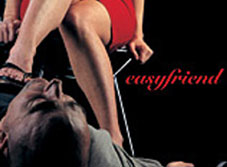
Roberto Aguirrezabala
Easyfriend
Création numérique | 0 | | 0:0 | Spain | 2007
Have you ever wondered what the company of a virtual friend would be like? When Elisabeth Vogler loses her voice in full flow whilst performing Electra she was not to know that it had been stolen from her by Alma, who would be her alter ego in the tortuous process of recovery. They both move to a house by the sea so that Elisabeth can get her voice back and recover her identity. A split search for identity in two characters who progressively fuse into a single person. Dialogue-monologue acts as a precarious vehicle for the longed for encounter that awaits them. This is Ingmar Bergman´s "Persona", a film that defines cinema and left its mark on Oriol, the protagonist in "Easyfriend". "Easyfriend" comes out of the search for identity through conversation. The user does not define his identity or decide on how he wishes to be shown to others. The project uses Artificial Emotional Intelligence to generate dynamic virtual identities. The user, on entering for the first time, projects his desire, what he expects from a relationship: friendship, love, sex, etc. When he shapes the identity of his virtual friend, in a psychoanalytic process, he constructs a future, expectations, an experience. From that point on, he will be able to deal with the relationship as his will dictates: he can hold onto it or forget it. His virtual friend will remain active so long as the relationship exists and provides him with conversation. When the creator stops communicating, his robot becomes inactive. What their desire craves is not a conventional relationship, but a situation that favours them and responds to their needs as incomplete unstable individuals. In this sense, "Easyfriend" is a hybrid project between cinema and net.art, exploring Internet narrative. Oriol is an artist who works with video and comes to the city to exhibit his work at a festival. As soon as he arrives, he turns up for an interview with Laura, an art journalist. The conversation starts moving and everything goes awry. She savagely attacks his work, accusing him of having a distanced perception of art, while he sees in her the reminder of a past relationship that he has not managed to get over and which has marked his life. Once this interview has taken place everything moves very fast. They each approach the relationship with different intentions and the ensuing confrontation sparks off a flurry of events that they both have to face head on. The narrative does not unfold sequentially: rather, it happens abruptly. The story can begin in the middle in order to advance, and then start off again at another point. The variants are infinite. The user will have to constantly go forwards and backwards in an action that requires him to take the initiative so as to understand the logic in the scenes. For this purpose he will be furnished with various tools designed so that he can use this narrative experience. At a particular point in the narrative, the two ways of experiencing "Easyfriend", the robot population, and the fictional plot, inevitably intersect, never to be separated again. Conversation with the easybot becomes a new narrative mechanism, at the user's disposal, where the flow of the story is deeper. The easybot can be asked questions about the characters, about what they think, the whys and wherefores of their behaviour, the way their relationships develop, therefore allowing it to be possible to attain knowledge of "Easyfriend" at a higher level.
Roberto Aguirrezabala was born in 1971 in Bilbao. He has a diploma in audiovisual studies and painting. After having dedicated himself to painting and sculpting from 1990-95, he started to concentrate his artistic activities on the Internet and audiovisual media. Since 1995 he has worked as an artistic director for the Internet. In 1999 he founded "l'Agencia Interactive Adclick", an agency specialized in the realization of projects for the Internet and digital communication. His research is currently centred on the development of narrative cinematic systems on the Internet, on photography, and on video and cinema.
Stella Ahn
Catalogue : 2014Curriculum | Experimental doc. | hdv | color | 8:34 | USA | 2013
Stella Ahn
Curriculum
Experimental doc. | hdv | color | 8:34 | USA | 2013
Curriculum is a tiny scale documentary set in Los Angelescentered around the larger theme of knowledge. It loosely follows a character, a tutor for the No Child Left Behind Act implemented by the Los Angeles Unified School District. Running through a few simple ideological questions rather than investigatingcharacters, facts, or events (as one would expect of a documentary), the film was made to open up the matter of education in Los Angeles in relation to socio-economic as well as subjective positions.
Stella Ahn is a Los Angeles native. With a B.A. in Film & Media Studies from the University of California, Irvine, she went on to California Institute of the Arts, where she received her MFA in Film/Video. She likes to make experimental narratives, essay films, and video loops. Her work focuses on unsteadily dismantling the intersections of image, fiction/reality, and politics.
Eija-liisa Ahtila
Catalogue : 2018Tutkimuksia draaman ekologiasta (Studies on the Ecology of Drama) | Experimental fiction | 4k | color | 26:26 | Finland | 2017
Eija-liisa Ahtila
Tutkimuksia draaman ekologiasta (Studies on the Ecology of Drama)
Experimental fiction | 4k | color | 26:26 | Finland | 2017
The film uses the methods of presentation as a path to the company of other living beings. It expands upon the issues of ecological moving image narrative, the focus being on presentation, imaging and imagination in the context of the moving image.
Eija-Liisa Ahtila is a renowned Finnish filmmaker and contemporary visual artist, born in Finland in 1959. She studied at the University of California, Los Angeles, at the London College of Printing and at the University of Helsinki. She has long been considered a master of the cinematic installation form. In 2011, the artist was appointed to the main jury of the Venice Film Festival and in 2013 she was the Chairwoman of the Jury in FIDMarseille. She is currently doing her PhD at the Academy of Fine Arts in Helsinki. Ahtila’s work is conceptually organized around the construction of image, language, narrative and space. Her earlier works dealt with unsettling human dramas of teenage sexuality, family relations, mental disintegration, and death. Her recent work tackles more profound and artistic questions where she investigates the processes of perception and attribution of meaning—at times through a cultural and existential thematic, like colonialism, faith, and post-humanism. Ahtila’s work has received many awards including the ARTE Award for Best European Film at the International Short Film Festival Oberhausen; the Great Prize Fiction at Vila do Conde International Short Film Festival, and the Best Nordic Short Film at Nordisk Panorama. Her crafted work was showed in some of the most prominent contemporary art museums and festivals including the Guggenheim, Bilbao; Monderna Museet, Stokholm; DHC/Art Foundation for Contemporary Art, Montreal; Jeu de Paume Paris; The Museum of Modern Art, New York; Museo d/Arte Moderna e Contemporanea, Bolzano, Italy, and Tate Modern, London. Her short films have also been shown at major festivals throughout the world, including Berlin International Film Festival, Sundance Film Festival, and Venice International Film Festival.
Eija-liisa Ahtila
Catalogue : 2013Marian Ilmestys | Video | hdv | color | 34:44 | Finland | 2011
Eija-liisa Ahtila
Marian Ilmestys
Video | hdv | color | 34:44 | Finland | 2011
The Annunciation is a film in which one of the central motifs of Christian iconography is constructed and re-enacted through moving image.
Eija-Liisa Ahtila Born in 1959 in Hämeenlinna, Finland, Eija-Liisa Ahtila is visual artist and filmmaker. Her films and multi-screen installations explore and experiment with narrative storytelling, creating extraordinary tales out of ordinary human experiences.
Catalogue : 2010MISSÄ ON MISSÄ? | Experimental film | 35mm | color and b&w | 55:50 | Finland | 2009
Eija-liisa Ahtila
MISSÄ ON MISSÄ?
Experimental film | 35mm | color and b&w | 55:50 | Finland | 2009
WHERE IS WHERE? is based on an incident which took place during the Algerian independence war in 1950?s. Reacting to the acts of violence committed by the French, two young Algerian boys murder their friend, a French boy. The story, told in multiple simultaneous images, starts in the present day as Death enters the house of the Poet. She starts to investigate these past events, which gradually become interwoven with the present moment. A mist clears from the back garden of the Poet`s house to reveal a small row-boat which has appeared in the swimming pool. In it sit Adel and Ismael.
EIJA-LIISA AHTILA Born in 1959 in Hämeenlinna, Finland, Eija-Liisa Ahtila is visual artist and filmmaker. Her films and multi-screen installations explore and experiment with narrative storytelling, creating extraordinary tales out of ordinary human experiences. Her works deal with separation, loss, sexuality, relationships among family members, mental disintegration, and death. They investigate the processes of perception and the attribution of meaning, with breaking down the story on several screens around the viewer in the space. Making installations and films has become for her a process of identifying the links between images, sounds, rhythms, light, characters and words, and using them to approach and construct the story. Eija-Liisa Ahtila was the recipient of the Artes Mundi of Cardiff, Wales in 2006, the Vincent Van Gogh Biannual Award for Contemporary Art in Europe, Maastricht, The Netherlands, as well as the Coutts Contemporary Art Foundation Award, Switzerland, both in 2000, and the Edstrand Art Prize, Sweden in 1998. Ahtila attended Helsinki University, Faculty of Law (1980-85); Independent Art School, 198184; and London College of Printing, School of Media and Management, Film and Video (1990-91). She received a Certificate from U.C.L.A. in Film, TV, Theater and Multimedia Studies, Los Angeles (1994-95) and attended special courses at the America Film Institute, Advanced Technology Program, Los Angeles (1994-95). Ahtila has exhibited extensively at numerous museums and film festivals around the world and her films have received distinctive film awards and prizes over the years. Her work has also been widely seen on television in Europe. British Film Institute has published a home DVD box of her films titled The Cinematic Works of Eija-Liisa Ahti/a. Eija-Liisa Ahtila currently lives and works in Helsinki.
Peggy Ahwesh, Jacqueline Goss
Catalogue : 2023OR119 | Experimental video | hdcam | color | 61:0 | USA | 2022
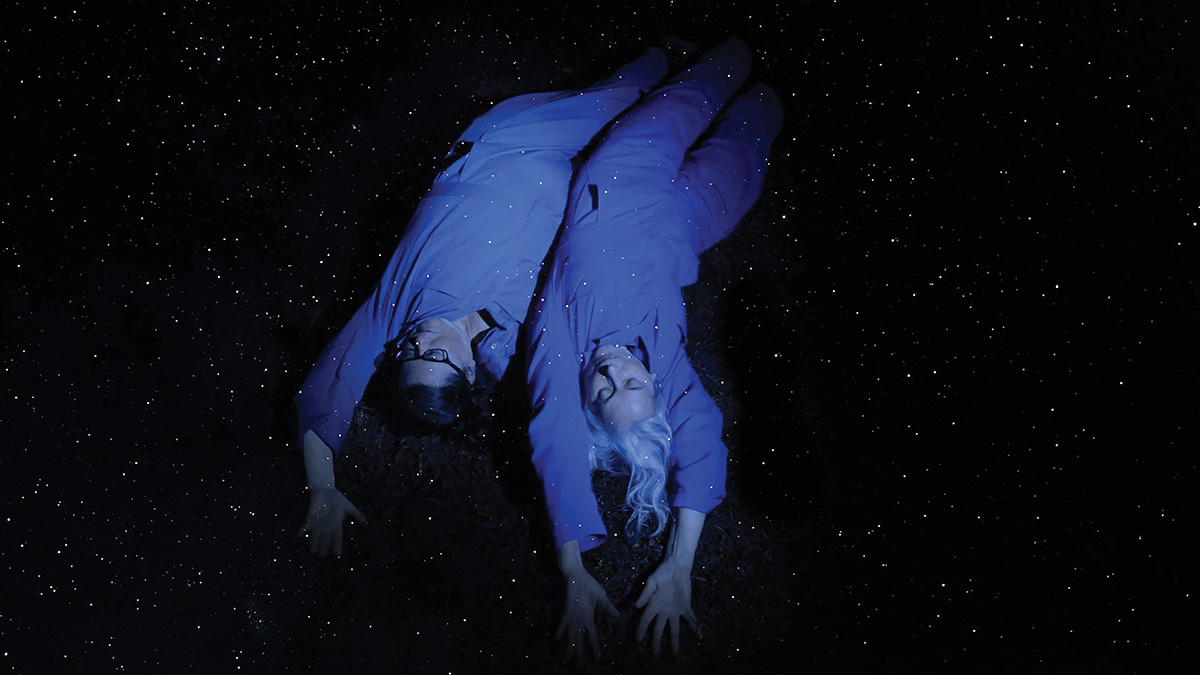
Peggy Ahwesh, Jacqueline Goss
OR119
Experimental video | hdcam | color | 61:0 | USA | 2022
OR119 is a theoretical musical based on the ideas of radical psychologist Wilhelm Reich who, as Freud’s favorite student, centered his study on the intersections of psychoanalysis and Marxism. Reich’s best work advocates for a re-imagining of family structure and gender roles, sexual liberation for younger people and the working poor and a deep understanding of the effect of fascisms on the body. OR119 is based on quotations by Reich set to song and also in imaginary conversations between Reich and a number of contemporary feminist thinkers. With a group of women friends in improvisation, we playfully examine the unsettled legacy of Reich and his surprisingly relevant dynamic with feminist thought. Reich proposed Orgone, a universal life energy (akin to Chi) based on sex and positive expression that Reich claims to have discovered, and here we grant him the honor of the next number on the periodic chart (OR119) for his discovery. The musical resonance and vibrations of the voices in song make manifest the invisible positive energy that Reich believed was universal. This is by no means a bio-pic! but it is a celebration of life's potential for immersion in nature, the cosmos and interactive energy.
PEGGY AHWESH has worked since the 70's in wide range of technologies and styles in an inquiry into feminism, cultural identity and genre. Featured in the Whitney Biennial (1991, 1995, 2002). Solo exhibitions include: Spike Island (2021); Kunsthall Stavanger (2022); Cleave (2019) Microscope Gallery, New York. Film retrospectives: Anthology Film Archives/NYC, Guggenheim Bilbao/Spain, New Media Fest Seoul/Korea, BFI/London and others. Ahwesh is Emeritus Professor from Bard College and al-Quds Bard College, West Bank, Palestine, where she taught media production and history. Collaborator JACQUELINE GOSS makes movies and web-based works that explore how political, cultural, and scientific systems change our sense of self through animation and live action in documentary and essay forms. Her work has shown at Eyebeam Atelier, The Wexner Center for the Arts and festivals in New York, London, Rotterdam. Goss has received awards from the Tribeca Film Institute, Creative Capital Foundation, the Rockefeller Foundation, Jerome Foundation, Herb Alpert Foundation, the United States Artist Award and the Berliner Kunstlerprogramm. Her videos are distributed by Video Data Bank in Chicago. She teaches Media at Bard College
Carlos Aires
Catalogue : 2018Sweet Dreams Are Made of This | Video | hdv | color | 4:21 | Spain | 2016
Carlos Aires
Sweet Dreams Are Made of This
Video | hdv | color | 4:21 | Spain | 2016
The video shows two policemen wearing Spanish anti-riot uniforms, dancing a tango version of the famous Eurhythmics 80´s song in the luxurious and extremely decorated ballroom space of the XIX century palace Museum Cerralbo in Madrid. The fantastic lyric of the song “ Sweet dreams are made of this ” is the central motor of the piece. The tango version cove song has been arranged by the bandoneon player Fernando Girdini and recorded exclusively for the video. In its origins, tango was mainly a dance between two men. Tango was the result of the cultural mix of locals with African, Italian and Hispanic immigrants. It was originally forbidden by the church and rejected by high society, which resulted in its development in poor suburbs and working-class slums. The video reflects about the last years crisis, 15M movement, the violent riots, Cataluña independency, brutality of Spanish police and military forces and the recent antidemocratic Spanish law ” Ley Mordaza ” (the Gag Rule), becoming illegal and punished to take photos or videos of police forces or use of the police uniforms without the Government’s permission. Desire, power, decadence and frustration: they shoot horses, don´t they?
Carlos Aires was born in Ronda, Spain in 1974. He obtained a bachelor in Fine Arts at the University of Granada in Spain. Upon graduating in 1997, he moved to the Netherlands and completed his postgraduate studies at Fontys Academy (Tilburg, Netherlands), HISK (Antwerp, Belgium) and Ohio State University (Ohio, USA). He was honored with prestigious grants and awards, including: OMI Residency (USA), Edith Fergus Gilmore Award (USA), Generation2008 Caja Madrid (Spain), Young Belgian Art Prize (Belgium), 1st Award Young Andalusian Artists (Spain), Fulbright (USA) and De Pont Atelier (the Netherlands). He has participated in numerous exhibitions in national and international institutions, such as: CAC (Malaga, Spain), MACBA (Barcelona, Spain), Boulder Museum of Contemporary Art (USA), Imperial Belvedere Palace (Vienna, Austria), MUSAC (Leon, Spain), BB6 Bucharest International Biennale (Bucharest, Romania), B.P.S. 22 (Charleroi, Belgium), 5th Thessaloniki Biennale (Thessaloniki , Greece), Museo de Arte Carrillo Gil (Mexico City, Mexico), Canada Contemporary Art Museum (Montreal, Canada). His work can be found within significant public collections: ARTIUM (Spain), MACBA (Spain), Fondation Francès (France), ARTER (Turkey), CAC (Spain), Maison Particulière (Belgium), Ministry of Culture of Spain, Progress Art (Saudi Arabia), National Belgium Bank (Belgium), 21c Museum (USA), MAK (Austria) among others.
Chantal Akerman
Catalogue : 2009D'est | Documentary | 16mm | color | 107:0 | Belgium, France | 1993
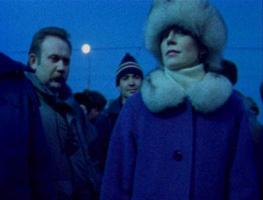
Chantal Akerman
D'est
Documentary | 16mm | color | 107:0 | Belgium, France | 1993
Impressions of Eastern Europe after the fall of the Berlin Wall. These countries, going through a change, which have lived a similar story since the war are still very scarred by this event deep in the roots of the ground going now different ways. A trip at the end of summer into the debts of winter, from the German border to Moscow.
Born on June 6, 1950, Chantal Akerman comes from a Jewish family of emigrants from Eastern Europe. Her mother was deported, and her film making is a constant link with this family trauma. She is accepted at the Institut Supérieur des Arts but her stay is short. She leaves for the United States and it is there, from the American avant-garde, that she draws most of its inspiration. Since then her career has taken her to France, the United States and Belgium, but also Germany and Russia, her country of origin. Specialist in experimental documentaries she embraces a more academic cinema with two films, the Appointments D `Anna and a Couch in New York, with Juliette Binoche and William Hurt. In 2004, the Pompidou center of Paris devotes an exhibition to her works. Akerman is also an actress on certain occasions, in films made by other film makers and he has also composed several pieces of music and films scripts.
Kasper Akhøj, Guimaraes, Tamar
Catalogue : 2014A Família do Capitão Gervasio | Experimental doc. | 16mm | black and white | 14:0 | Denmark, Brazil | 2013
Kasper AkhØj, Guimaraes, Tamar
A Família do Capitão Gervasio
Experimental doc. | 16mm | black and white | 14:0 | Denmark, Brazil | 2013
Captain Gervasio`s Family is a 16mm black and white silent portrait of a Spiritist community in Palmelo, a small town in the interior of Brazil. It?s a town of 2000 inhabitants, half of whom are psychic mediums. The film refers to a map drawn by a Spiritist woman in Palmelo, charting twenty astral cities hovering above the whole of the Brazilian territory. Cities ?like those on earth, but infinitely more perfect?. The Spiritists in Palmelo practice what is known as `the magnetic chain?, a legacy from the German physician Franz Mesmer, the founder of Spiritism Allan Kardec, and the French botanist François Deleuze. The film is a collaboration between the artists Tamar Guimaraes (BR) and Kasper Akhøj (DK).
Kasper Akhøj was born in Copenhagen, Denmark where he lives and works. He studied at the Czech National Film School (FAMU), Städelschule - Staatliche Hochschule für Bildende Künste, Frankfurt, and the Royal Danish Academy of Fine Arts, Copenhagen. He is also a former participant of the Whitney Museum Independent Study Program in New York. He is represented by Ellen de Bruijne Projects in Amsterdam and has exhibited widely at major museums and biennials, both solo and in collaboration with Brazilian artist Tamar Guimaraes, most recently at last years 55th Venice Biennale, The Encyclopedic Palace. Tamar Guimarães was born in Belo Horizonte, Brazil and lives and works in Copenhagen, Denmark. She holds a BFA from Goldsmiths College, University of London, and MFA from Malmö Art Academy, Sweden. She is also a former participant of the Whitney Museum Independent Study Program in New York. She is represented by Galeria Fortes Vilaça in Sao Paolo, and has exhibited widely at major museums and biennials, both solo and in collaboration with Danish artist Kasper Akhøj, most recently at last years 55th Venice Biennale, The Encyclopedic Palace.
Edward Akrout, Jakob S. Boeskov
Catalogue : 2018Quantum Political Feedback | Experimental video | hdv | color | 8:0 | France, United Kingdom | 2017
Edward Akrout, Jakob S. Boeskov
Quantum Political Feedback
Experimental video | hdv | color | 8:0 | France, United Kingdom | 2017
In the video, the artists combine pseudoscience with repetition to investigate the connection between technology and truth. An E-meter device was exploited as a crude polygraph machine. Its pseudoscientific function is to "detect lies" in order to monitor a statement`s progression from lie to truth. Statements were read to and repeated by the participants. Through continuous repetition, the subjects built a relationship with the spoken words, which over time, matured into experiences and finally beliefs. All of the combined elements resulted in mettre en abîme the transformation of a political affirmation into a belief.
Edward Akrout is a Franco-British artist that works between London, New York and Paris. His practice, which largely includes painting, drawing and sculpting, is best described as abstract expressionism. Personal website: EdwardAkrout.com Representation: Lahd Gallery Jakob Boeskov is a Danish-Icelandic artist and filmmaker that works between New York and Copenhagen. Having graduated from The Royal Danish Academy of Fine Arts, his pieces have been shown in museums such as New Museum, Science Politiques, Moscow State Academy Art Institute and the Stedelijk Museum. Personal website: JakobBoeskov.com Representation: The Scandinavian Institute
Monira Al Qadiri
Catalogue : 2018The Craft | Experimental film | hdv | color | 16:0 | Kuwait | 2017
Monira Al Qadiri
The Craft
Experimental film | hdv | color | 16:0 | Kuwait | 2017
“ The Craft ”is a film that revolves around childish fictions laced with serious suspicions towards the real world. Using the lens of family history, the film dissects the artist’s own past to reexamine an uncanny relationship taking place in the shadows of her major life events: “ Were my parents conspiring with aliens behind my back ” Reality gradually disintegrates like quicksand around this central question, as paranoia and speculation begin to take hold. Futuristic architecture, popular culture, dream readings, junk food, alien abductions, geopolitics, international diplomacy, war and peace; all of these once solid staples of modern life now become tinted with a general sense of distrust, overshadowing everything. Like a ticking time bomb at the center of the nuclear family unit, the suspicion reaches a crescendo when the protagonist suddenly discovers that the American century has finally ended.
Monira Al Qadiri is a Kuwaiti visual artist born in Senegal and educated in Japan. In 2010, she received a Ph.D. in inter-media art from Tokyo University of the Arts, where her research was focused on the aesthetics of sadness in the Middle-East stemming from poetry, music, art and religious practices. Her work explores unconventional gender identities, petro-cultures and their possible futures, as well as the legacies of corruption. She is also part of the artist collective GCC, who held a solo exhibition at MoMA PS1 in New York (2014). Monira was recently based in Amsterdam, and underwent a two year artist residency at the Rijksakademie until the end of 2017.
Catalogue : 2016Behind the Sun | Video | hdv | color | 10:0 | Kuwait | 2013
Monira Al Qadiri
Behind the Sun
Video | hdv | color | 10:0 | Kuwait | 2013
After the first Gulf War in 1991, countless oil fields in Kuwait were set ablaze during the retreat of invading forces. Those months following the war were nothing short of the classic image of a biblical apocalypse: the earth belching fire and the black scorched sky felt like a portrait of hell as it should be, an almost romanticized vision of the end of the world. Werner Herzog, lured by the surrealism of this present-day hell, shot his docu-fiction film “Lessons of Darkness” there which placed images of the oil fires alongside Christian biblical texts and a Wagner soundtrack. Inspired by his endeavor, this video re-explores the cataclysmic event and attempts to expand its meaning, especially as the idea of imminent doom is even more omnipresent today. Amateur VHS video footage of the oil fires is juxtaposed with audio monologues from Islamic television programs of the same period. At the time, the tools used to represent religion were geared towards visualizing god through nature. Trees, waterfalls, mountains, and animals were the visual staple of religious media, and the narration was not that of the Koran, but of Arabic poetry recited by a skilled orator with a deep voice.
Monira Al Qadiri is a Kuwaiti visual artist and film maker born in Senegal and educated in Japan. In 2010, she received a Ph.D. in inter-media art from Tokyo University of the Arts, where her research was focused on the aesthetics of sadness in the Middle-East region stemming from poetry, music, art and religious practices. Her work explores the relationship between narcissism and masculinity, as well as other dysfunctional gender roles. She is currently expanding her practice towards social and political subjects. Al Qadiri has taken part in exhibitions and film screenings in Tokyo, Kuwait, Beirut, Dubai, Berlin, New York and Moscow among others. She is also part of the artist collective GCC, who has recently held a solo exhibition at MoMA PS1 in 2014.
Monira Al Qadiri
Catalogue : 2023Crude Eye | Experimental film | 4k | color | 10:0 | Kuwait, Germany | 2022
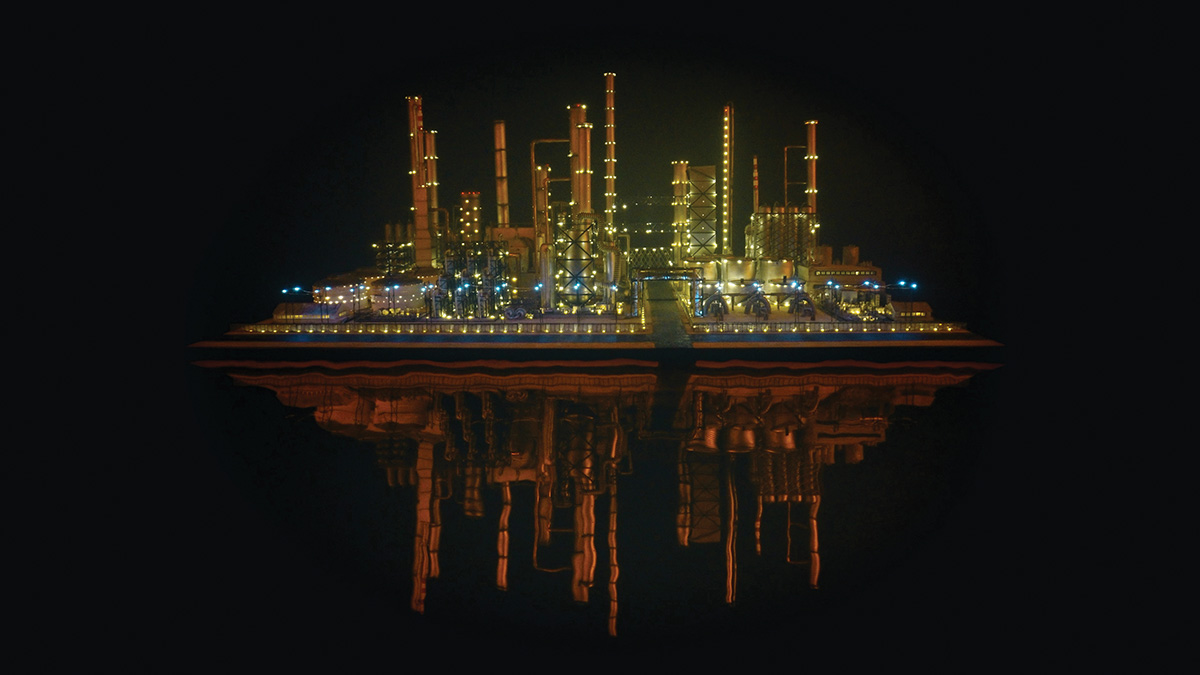
Monira Al Qadiri
Crude Eye
Experimental film | 4k | color | 10:0 | Kuwait, Germany | 2022
Growing up in Kuwait close to an oil refinery by the sea, the artist would create stories for the distant petroleum operation while passing by on a traffic bridge. As she envisioned an expansive panorama of lights, fire, smoke, and towers, Al Qadiri imagined it was a city-metropolis—"filled with beings and phantoms from another world.” This dream-like film hearkens back to these childhood memories, fusing eerie, slow views of a reconstructed miniature refinery with lines from poems about city lights and industrial landscapes. Crude Eye blurs reality with speculative memory, and we are unable to tell if the scene is a real place or a fantasy. The artist says: “The work attempts to reconcile a sense of childlike wonder with the toxic environmental destruction that the refinery inherently represents.”
Monira Al Qadiri (b. 1983) is a Kuwaiti visual artist born in Senegal and educated in Japan. Spanning sculpture, installation, film and performance, Al Qadiri's multifaceted practice is mainly based on research into the cultural histories of the Gulf region. Her interpretation of the Gulf's so-called "petro-culture" is manifested through speculative scenarios that take inspiration from science fiction, autobiography, traditional practices and pop culture, resulting in uncanny and covertly subversive works. She is currently based in Berlin.
Loukia Alavanou
Catalogue : 2023On the Way to Colonus | VR 360 video | mov | color | 20:0 | Greece | 2021
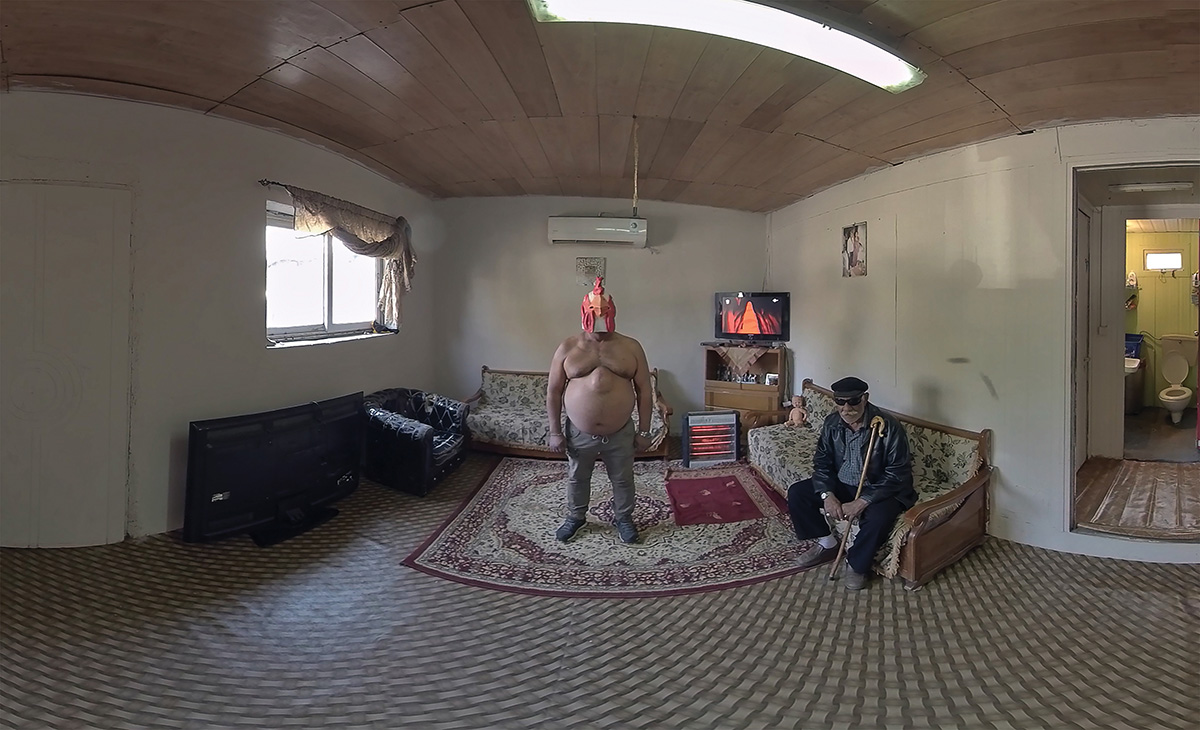
Loukia Alavanou
On the Way to Colonus
VR 360 video | mov | color | 20:0 | Greece | 2021
Blind Oedipus, in older age, left Thebes as an exile accompanied by Antigone, who was both his daughter and sister. They sought refuge in Colonus of Athens. What if the tragic hero of Sophocles’ play 'Oedipus at Colonus' was a Romani nomad residing in today’s post-industrial outskirts of western Athens? OTWTC is a ‘docufictional’ VR film cast with Romani amateurs who live at the ghettoised toxic wastelands of Thriasian Plain, where Sophocles’ wandering hero is meant to have passed from. Consisted of a spatial sound design (ambisonics), the film's audio incorporates location sounds recorded inside the dwellings that merge “high” and “low” culture, often carrying with them the “eerie echoes” of dubbed TV series, speaking themselves about “Oedipal conflicts”, ‘absent fathers’, ‘incest’, murder and death.
Loukia Alavanou is a moving image artist and filmmaker. She is representing Greece at the 59th Venice Art Biennale with the exhibition “Oedipus in Search of Colonus. Alavanou holds an MA in Photography from the RCA in London. She was the winner of the 5th Deste Prize. In recent years, after receiving international acclaim, she started to be involved with the production of VR films and founded the first VR production company in Greece. She held a retrospective exhibition at State of Concept, Athens in 2018. For the years 2021 and 2022 Alavanou is a fellow artist at ONX Studio, organised by Onassis USA and the New Museum in NY. Alavanou’s work has been presented by institutions and festivals including KANAL Centre Pompidou, Accelerator, Stockholm, Gucci Garden, Kino Der Kunst, Palais de BOZAR, Palais de Tokyo, Athens Biennale, Moscow Biennale, Fiorucci Art Trust, The Museum of Cycladic Art, Benaki Museum. Her films are part of numerous collections including the Onassis Collection, the Dakis Joannou Collection, The Center for Art and Media Karlsruhe/ ZKM, PCAI/ Polyeco Contemporary Art Initiative.
Michiel Alberts
Catalogue : 2018Another Gate Before the Law | Experimental video | hdv | black and white | 17:13 | Netherlands | 2017
Michiel Alberts
Another Gate Before the Law
Experimental video | hdv | black and white | 17:13 | Netherlands | 2017
Another Gate Before The Law (HDVideo, B&W, 17m13, Michiel Alberts, 2017) Michiel Alberts is currently working on a series of K. Films. The films relate to different short texts by F. Kafka. Michiel Alberts performs and films his actions in order to transform the stories into a visual image bringing it to current and existential scenery. The film Another Gate Before The Law refers to the text Before the Law, by F. Kafka. The film is a dark poetic image dealing with the present state of our time and to current human conditions.
(Born The Netherlands, 1972. Lives and Works in Antwerp, Belgium.) Michiel Alberts is a Visual artist working with the media Performance, Film and Photography. In his film works he focuses upon his performative presence, movements with duration or repetitive actions. Through the usage of single angel point, the audience is invited to experience a frozen state and relate to existential questions and human conditions. His films can be described as a still picture moving, a state of presence unresolved. “ My physical presence functions as a performative tool to question human conditions, cosmic order, time and landscapes. Through forms of abstraction I bring my content from a specific happening, or a specific social context to a larger existential scenery." Michiel Alberts has studied Visual Art at the H.I.S.K. institute in Antwerp and Gent (2008). He also completed a Master of Arts at Dasarts in Amsterdam (2005) and completed the Acting School of Maastricht (1997)